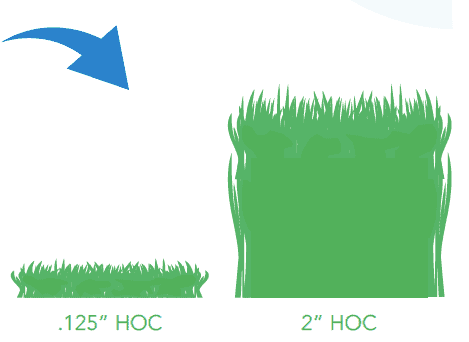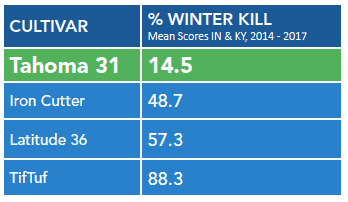
The newest Bermudagrass on the world market, Tahoma 31® offers the very best turf quality plus big savings on irrigation and mowing. Tahoma 31 is a leap forward from older varieties like Celebration and TifTuf, ranking #1 in comparative trials for low water use, traffic and shade tolerance, cold tolerance and early spring green-up, and overall turf quality.
Developed at Oklahoma State University in the USA, Tahoma 31 requires less mowing than competitive varieties, due to its lower vertical growth rate, and on average requires 18% less water than TifTuf and 14% less water than Celebration.
All with beautiful color and texture. Tahoma 31 is available on the ground, in Vietnam, right now.
Downloads
#1 in Turf Quality
The National Turfgrass Evaluation Program, or NTEP, is a series of comparative trials organized by the U.S. Department of Agriculture, at sites spread across the United States so as to expose turgrass varieties to all the different climate conditions. Each NTEP series runs for five years, and compares several dozen turfgrass varieties.
Turf quality ratings conducted by NTEP tests at 17 locations over 5 years show Tahoma 31’s exceptional turf quality among Bermudagrasses, when tested against both vegetative & seeded varieties.


#1 IN TRAFFIC TOLERANCE
In the “Turfgrass Quality Under Traffic” section of the NTEP National Bermudagrass Test at Knoxville, TN, Tahoma 31 exhibited excellent traffic tolerance compared to all other Bermudagrass cultivars tested.
#1 FOR LOW WATER USE
In tests that measured evapotranspiration (ET) rates (mm d-1) under non-limiting soil moisture conditions in Oklahoma (Amgain et al., 2018, Crop Sci. 58:1409), Tahoma 31 fared best, while TifTuf used the most water. Overall, Tahoma 31 used 18% less water than TifTuf.


#1 IN SHADE
“These values are means across 6 rating dates in 2018 & 2019 and are presented with no statistical analysis. That being the case, it is highly likely several of these grasses are statistically equivalent. Other considerations are that plots received no traffic and were mowed at 1.5-inches once per week. In our opinion, Tahoma 31 is a great choice (among Bermudagrasses) for partial shaded locations in the transition zone of the US, although clearly many of the newer grasses are an improvement over the old standard Tifway.”
– Analysis of preliminary findings of the Stillwater location SCRI shade trial, Charles Fontanier, Ph.D., Assistant Professor – Turfgrass Science, Dept of Horticulture & Landscape Architecture, Oklahoma State University.
Soft, Comfortable, Beautiful
In 2017, 65,000 square feet of Tahoma 31 was planted on the event lawn at Shangri-La Golf Club & Resort in Monkey Island, Oklahoma, USA. For the Fourth of July Independence Day celebration in 2018, neither the fireworks nor the hot dogs were the topic of conversation; instead, Tahoma 31 drew the most attention. “That’s when people really started noticing the grass,” says Justin May, golf course superintendent. “We had the Fourth of July celebration and I don’t know how many hundreds of people were there, but none of them sat in their chairs. They all sat in the grass because it was so soft.”
LOWER HEIGHT OF CUT
Tahoma 31 adapts to a wide range of height of cut (HOC), from 5 cm (2”) to as low as 3.2 mm (0.125”), according to multiple university research data. “The low end of HOC of Tahoma 31 has not been seen on other popular cultivars including Latitude 36, NorthBridge, TifTuf, or Tifway,” says Dr. Yanqi Wu of Oklahoma State University.
Source: Wu, Y.Q., D.L. Martin, J.Q. Moss, C.H. Fontanier, N. Walker, A. Chandra, B. Wherley, K.E. Kenworthy, B. Unruh, P.R. Munoz, B.M. Schwartz, P.L. Raymer, F.C. Waltz, S. Milla-Lewis, and G.L. Miller. 2019. “Tahoma 31 Bermudagrass: A New Cold Hardy, Drought Resistant and Traffic Tolerant Turf Cultivar.” ASA-CSSA-SSSA International Annual Meeting. November 10-13, San Antonio, TX


#1 IN EARLY SPRING GREEN-UP
In NTEP tests from 2014 – 2017, Tahoma 31 ranked at the top spot for early spring green-up among all vegetative Bermudagrass cultivars tested in 16 states.
#1 IN COLD TOLERANCE:
WINTER SURVIVABILITY
The winter of 2013–2014 swept a polar vortex into the Midwest that created record low temperatures. Dr. Cale Bigelow, a professor of turf science and ecology at Purdue University in Indiana, participated in the NTEP study there. In a December 2019 article in Golf Course Management magazine, Dr. Bigelow was quoted as saying only 9 of 42 Bermudagrasses tested survived that 2013-14 winter with at least 50% ground cover by spring. Several of the 14 grasses completely died. By the end of the NTEP study, Tahoma 31 was rated with by far the greatest winter survivability, at only 4% winter kill. Mean scores in two states where winter survivability was measured, Indiana and Kentucky, confirmed Tahoma 31’s top status in the three year study period, 2014–2017.




